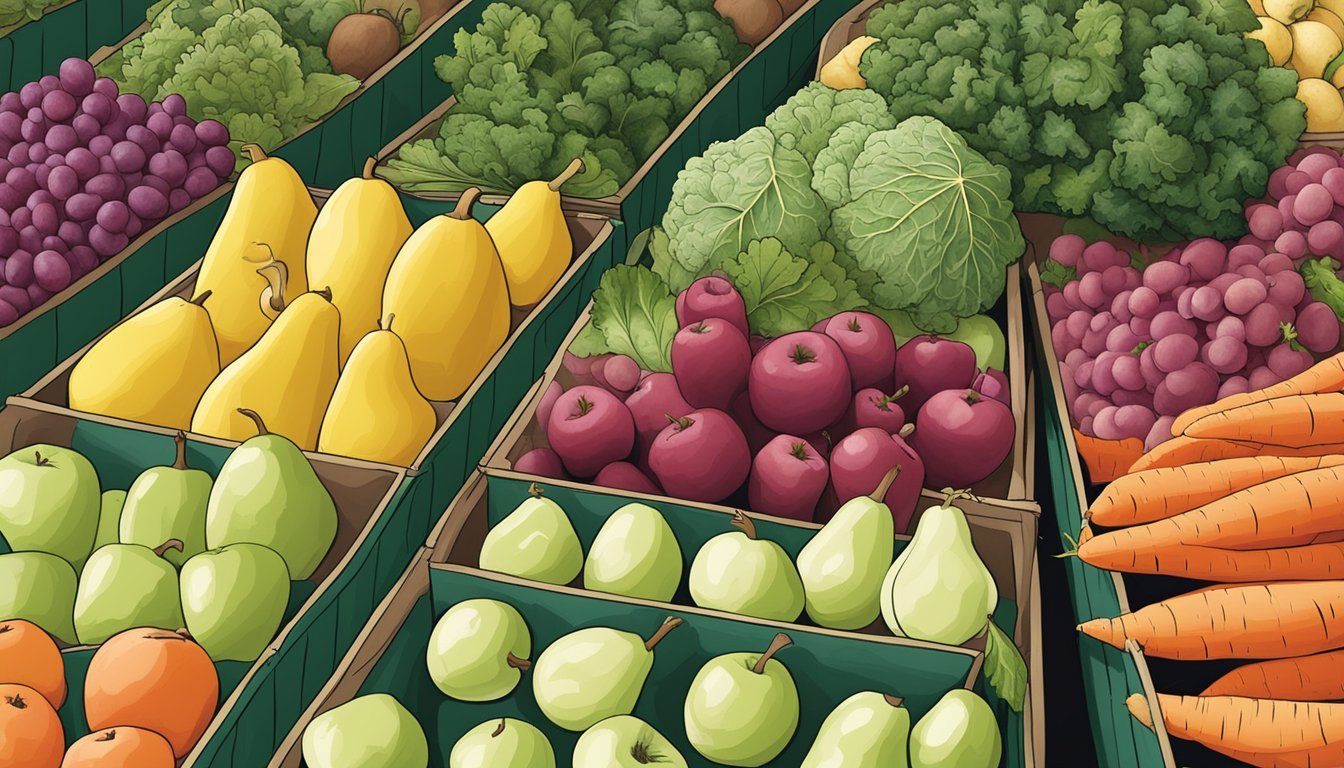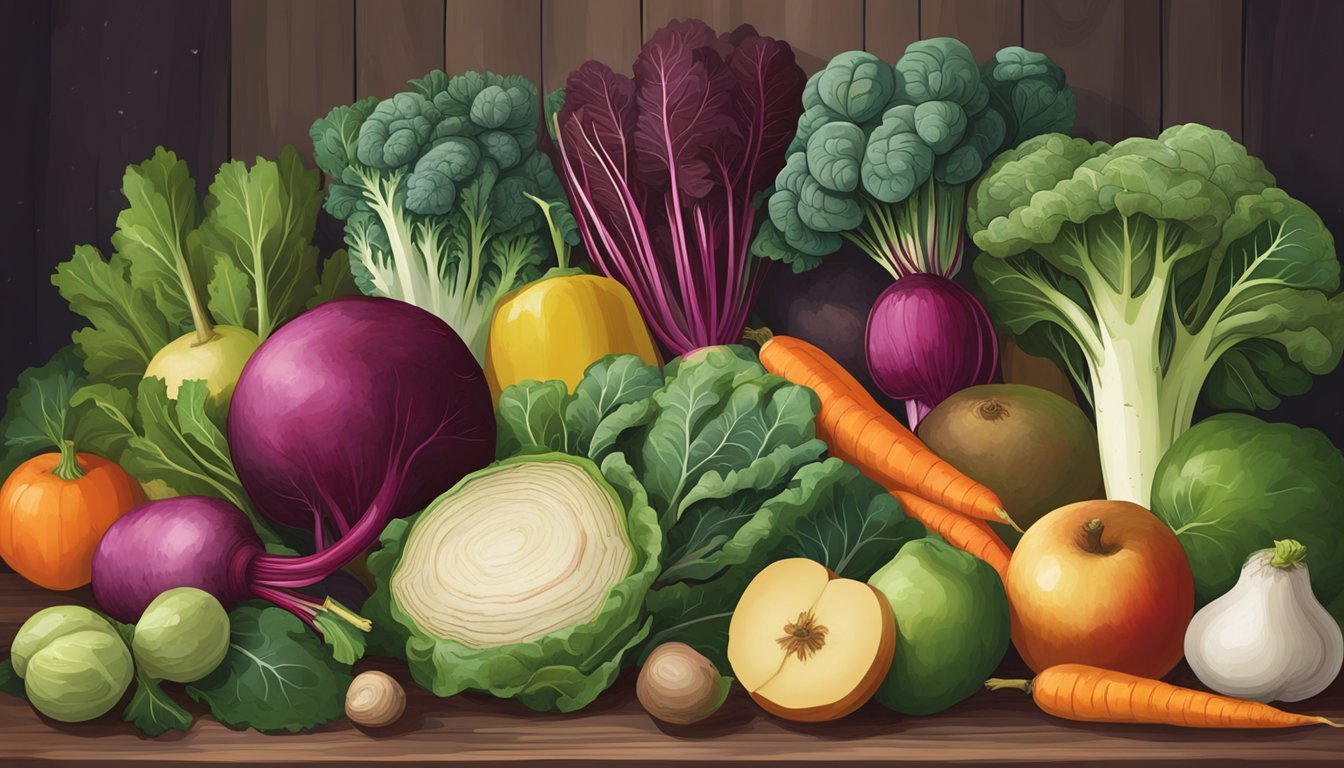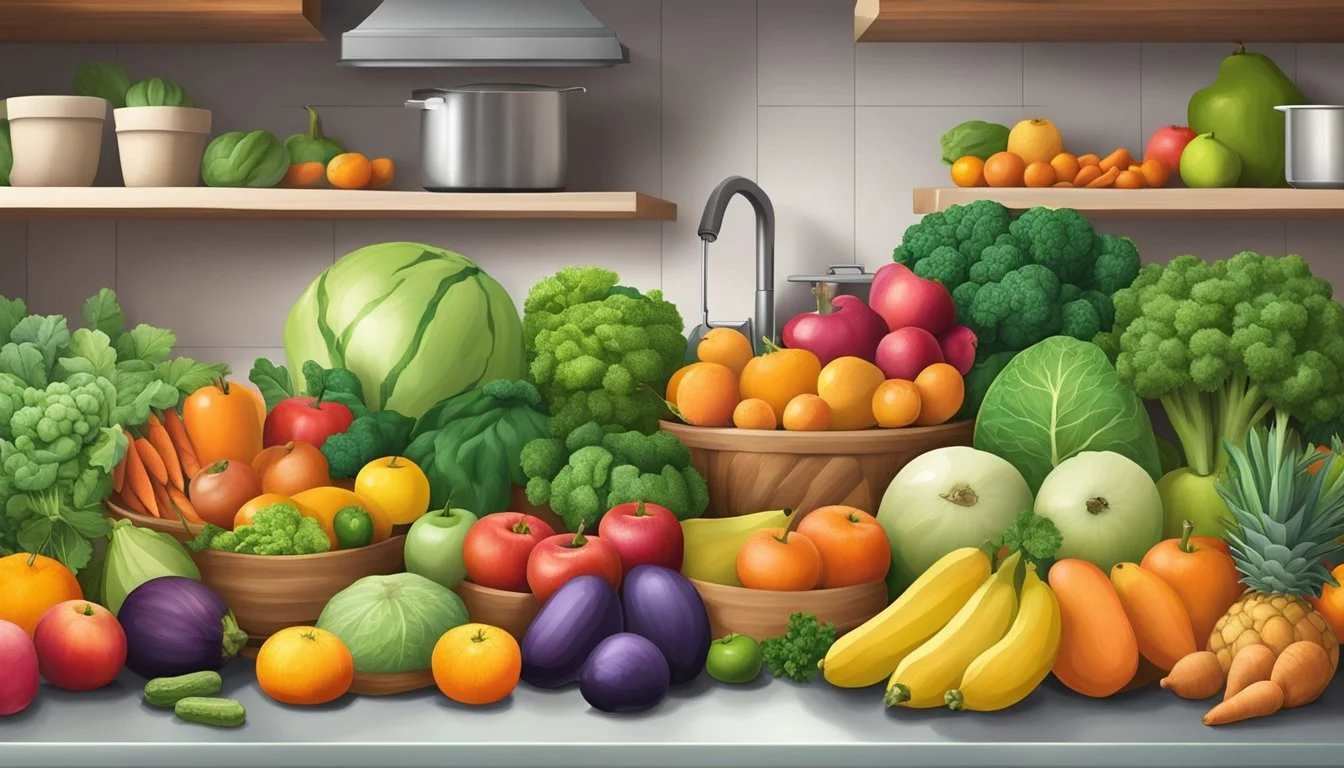Maryland Seasonal Fruit & Vegetables in February
Your Guide to Winter Produce Selection
This Article is Part of our Maryland Seasonal Fruit & Veg Calendar
February in Maryland offers a unique array of fruits (What wine goes well with fruit?) and vegetables that thrive in the cooler months. This period is marked by the abundance of citrus fruits, such as lemons, limes, and oranges, which reach peak ripeness during winter. The cooler temperatures allow for the sweet and tangy flavors of these fruits to develop fully, making them a vibrant addition to the local produce selection. Consumers have the opportunity to integrate these nutritious and flavorful citrus fruits into their diets, appreciating the seasonal bounty that February brings.
Vegetables suited to the chill of Maryland winters are also available, ensuring that local inhabitants can enjoy fresh produce despite the cold. Root vegetables like beets (how long do beets last?), which can be stored effectively, remain a staple in the winter diet, alongside greenhouse-grown or stored products like green beans and lima beans. (how long do lima beans last?) These vegetables are not only versatile in culinary applications but also rich in essential vitamins and minerals, contributing to a balanced diet during the winter months.
The emphasis on seasonal eating in Maryland highlights the state's agricultural adaptability and commitment to providing fresh, local produce throughout the year. This approach fosters a sustainable food culture, supports the regional economy, and encourages residents to explore and appreciate the flavors distinct to each season. February may have a more limited variety compared to the summer months, but the offerings are nevertheless cherished for their freshness and quality.
Overview of Maryland's February Produce
Maryland's February produce offers a variety of winter vegetables, despite the cold season's challenges.
Distinctive Climate for February Harvests
The climate in Maryland during February typically features cold temperatures and occasional snow, which greatly influences the types of produce that can be harvested during this month. Farmers in the state rely on season extension techniques like greenhouses and cold frames to grow certain crops, but most winter produce consists of hardy vegetables that can withstand the lower temperatures.
Nutritional Value of Seasonal Produce
Emphasizing on the nutritional benefits, winter produce in Maryland includes a selection of root vegetables and hardy greens that are rich in essential vitamins and minerals. Consuming these seasonal vegetables ensures high-quality nutritional intake, supporting overall health during the colder months.
Vegetables Available:
Beets
Brussels sprouts (how long do brussels sprouts last?)
Cabbage
Carrots (how long do carrots last?)
Potatoes
The selection of fruits in February is more limited as the state's orchards lie dormant. However, apples from cold storage continue to be available, providing a fresh and nutritious option for fruit lovers.
Fruit Highlights in February
In February, Maryland's fruit offerings may be less abundant than in the summer months, but certain fruits remain readily available and flavorful, namely citrus fruits and stored apples and pears.
Citrus Fruits Availability
During February, citrus fruits are at their peak in Maryland. Consumers can find a variety of citrus, including sweet oranges, tart grapefruits, and the uniquely flavored blood oranges. These fruits are often sourced from warmer climates but are widely available in local markets during this season.
Lemons: Consistent supply available, versatile for both culinary and household uses.
Blood Oranges: Known for their deep red flesh and sweet-tart flavor, a seasonal favorite.
Grapefruits: Ranging from white to ruby red, a nutritious option rich in vitamins.
Apples and Pears Selection
While the apple harvest season ends in the fall, many varieties of apples remain available through controlled cold storage. Pears follow a similar pattern, with storage extending their availability into the winter months.
Apples: Look for varieties like Fuji or Granny Smith, which keep well and maintain flavor.
Pears: Bartlett and Anjou pears are typically in supply, offering a sweet and juicy choice for consumers.
Local Market Varieties
Maryland markets continue to showcase a selection of fruits that may include both locally stored produce and items sourced from other regions to ensure variety.
Apples: Ranging from tart to sweet, suitable for eating fresh or used in Maryland's seasonal recipes.
Pears: Often found next to apples, pears provide a soft, buttery alternative for winter fruit options.
Patrons are encouraged to visit their nearest farmers' market or grocery store to explore the full range of available fruits this February.
Vegetable Highlights in February
In Maryland, February offers a variety of cold-hardy vegetables that thrive in the region's wintry conditions. The focus for this month includes nutrient-rich root vegetables, robust cruciferous options, and practical tips for selecting and preserving these seasonal offerings.
Root Vegetables and Tubers
Carrots and beets are prime examples of February's bounty in Maryland. They boast a high nutritional value and a sweetness enhanced by the cold weather. Sweet potatoes (What wine goes well with sweet potatoes?), although traditionally harvested in the fall, may still be available from proper storage, providing a versatile and flavorful option for meals.
Carrots: Rich in beta-carotene and versatile in dishes from soups to desserts.
Beets: Known for their earthy flavor and deep red color, adding vibrancy to salads and side dishes.
Sweet potatoes: Provide a wealth of fiber and can be prepared in various ways, from baked to mashed.
Cruciferous Vegetables and Greens
February is also a suitable time for cabbage, kale, broccoli, and Brussels sprouts—vegetables noted for their cold tolerance and health benefits. These greens can withstand frost, which often sweetens their taste.
Cabbage: Available in several varieties for slaws or fermented into sauerkraut (how long does sauerkraut last?).
Kale: Offers a hearty texture for salads and a nutritional boost when cooked.
Broccoli: An excellent source of vitamins and can be enjoyed raw or cooked.
Brussels sprouts: When roasted, they develop a nutty flavor that many find appealing.
Selection and Storage Tips
When selecting vegetables in February, look for firmness and color vibrancy. The freshest vegetables will often have crisp leaves and a healthy-looking exterior. For storage, keep root vegetables in a cool, dark place and most greens in the refrigerator's crisper drawer. Raw vegetables maintained under proper conditions can last several weeks, preserving their nutritional quality and taste.
Storage: Root vegetables like beets and carrots should be stored in a cool, dark, and well-ventilated area. Sweet potatoes prefer slightly warmer storage conditions to prevent chilling injury.
Preparation: Prior to use, wash these vegetables thoroughly to remove any soil or debris. Spinach and other leafy greens should be eaten soon after purchase to enjoy their peak freshness and flavor.
Culinary Uses and Recipes
February in Maryland brings a bounty of hearty vegetables and storage fruits that lend themselves well to a variety of culinary applications. Focusing on seasonal produce ensures vibrant flavor and nutrition in every dish.
Warm Dishes and Comfort Foods
Winter in Maryland offers an excellent opportunity to create warm dishes and comfort foods featuring winter squash, sweet potatoes, and pumpkin. These vegetables can be transformed into nourishing soups or roasted as a side dish. One can make a Butternut Squash Soup with hints of ginger and cream or a Roasted Acorn Squash filled with a mixture of quinoa (how long does quinoa last?) and cranberries. A Pumpkin Chili serves as a robust and warming option for cold February evenings.
Fresh Salads and Raw Eats
Although winter is not typically associated with fresh salads, Maryland's February produce still affords the chance to incorporate raw vegetables into meals. Utilizing storage vegetables like carrots and adding greens like arugula and lettuce, chefs can craft vibrant salads. A simple Carrot and Arugula Salad with lemon vinaigrette showcases these ingredients' crisp textures and bright flavors, making it a refreshing side or starter.
Preservation and Fermentation
Preservation techniques such as canning and fermentation come in handy when considering vegetables harvested in the earlier months but still available from storage. Fermented Sauerkraut made from cabbage or Pickled Beets are not only enjoyed as condiments but also add a tangy twist to main dishes. These methods extend the life of produce and enhance their nutritional profile with probiotics.
Desserts and Sweet Treats
Storage fruits like apples and pears or late harvests like sweet potatoes serve as the foundation for delectable desserts and sweet treats. An Apple Crisp with a cinnamon-oat crumble or a Pear Tart with almond cream allows these fruits' natural sweetness to shine. For a twist on classic desserts, one might bake a Sweet Potato Pie infused with spices like nutmeg (how long does nutmeg last?) and clove that capture February's essence.
Food Sustainability and Seasonality
In Maryland, February brings a unique array of seasonal produce that contributes to food sustainability and has a positive environmental impact. Understanding the seasonality of food helps consumers make informed choices that support local agriculture and enhance health.
Benefits of Eating Seasonally
Consumers in Maryland who choose to eat seasonally can enjoy a range of health benefits. Seasonal produce tends to be fresher, packed with optimal nutrients, and is more flavorful than out-of-season fruits and vegetables. For example, Maryland's February produce may include nutrient-rich leafy greens, root vegetables, and stored apples from the previous fall harvest. Eating in accordance with the seasons also introduces a healthy variety to one's diet, encouraging a diverse intake of vitamins and minerals.
Supporting Local Agriculture
When Marylanders purchase seasonal produce, they are supporting local farms and markets, bolstering the state's agricultural economy. Local markets often offer a selection of seasonal produce that is harvested at peak ripeness. By investing in these local products, consumers help create a stable demand for seasonal items, which can lead to increased job opportunities within their communities and contribute to the overall vitality of Maryland's agricultural sector.
Environmental Impact
Seasonal eating in Maryland significantly reduces environmental impacts. Local and seasonal produce eliminates the need for long-distance transportation, resulting in lower carbon emissions and less packaging waste. Farms that grow produce in sync with the seasons use sustainable practices that are more likely to conserve water, encourage soil health, and reduce the dependence on chemical pesticides. The Maryland agricultural community is increasingly embracing these environmentally friendly methods, promoting sustainability across the state.
Where to Buy Seasonal Produce
In February, individuals in Maryland can purchase seasonal fruits and vegetables from various sources, ensuring freshness and supporting the local economy. Each option offers its unique benefits, from the freshness of farmers' markets to the convenience of online marketplaces.
Local Farmers' Markets
Farmers' markets provide an opportunity for consumers to buy directly from the source. They can find a selection of winter produce and goods often grown in Maryland-local farms. Markets such as the Silver Spring Farmers Market and the Baltimore Farmers' Market & Bazaar operate year-round and are a good place to find local, sometimes organic produce, even in the colder months.
Grocery Stores and Co-ops
Grocery stores and food co-ops offer a wide range of local and organic produce. Establishments like MOM's Organic Market and Common Market Co-op prioritize local produce, making it easier for shoppers to support Maryland farmers. They usually ensure that seasonal vegetables and fruit are available for their customers.
Community Supported Agriculture (CSA)
CSA programs allow community members to support local agriculture by subscribing to receive a portion of the harvest throughout the season. Maryland has numerous CSA options such as Sassafras Creek Farm in St. Mary's County, where members get fresh, organic vegetables directly from the farm on a regular basis.
Online Marketplaces
For convenience, online marketplaces provide an avenue for ordering local Maryland produce for delivery or pickup. Platforms such as Maryland's Best Market offer a variety of local products, including seasonal fruits and vegetables, with the ease of online shopping. Consumers can place orders and receive fresh local produce without having to leave their homes.
Conclusion
February in Maryland, while not the peak season for the state's produce, nonetheless offers a variety of fruits and vegetables that can be enjoyed. Residents and visitors alike have access to an array of seasonal produce that does well in the cooler temperatures.
Fruits available during this month are more limited but may include storage varieties of:
Apples
Pomegranates
Vegetables take center stage, offering robust flavors and nutrition:
Beets
Brussel Sprouts
Cabbage
Carrots
Cauliflower
Collards
Kale
These vegetables are often celebrated for their hardiness and their capacity to infuse winter dishes with both taste and color. It's imperative to recognize the seasonal nature of these items, as it underscores the importance of local produce consumption, supporting not just a healthier lifestyle but the local economy as well.
By incorporating these seasonal items into meals, individuals participate in a sustainable food culture that cherishes the rhythms of nature and the bounty it provides, even in the colder months. The nutritional benefits of consuming fresh, in-season produce are significant, offering a boost to one's health during winter when it's most needed.
Maryland's February offerings, though modest, are a testament to the region's agricultural adaptability and the joys of seasonal eating.






